R. Lorenz, TU Berlin, Einsteinufer 17, 10587 Berlin, Germany,
M. Sachwitz, H.J. Schreiber and F. Tonisch, DESY-IfH Zeuthen, Germany
The transverse beam position has to be measured at each superconducting
quadrupole in the TESLA Test Facility Linac with a resolution of better
than 10 ![]() m. Therefore, a cylindrical cavity excited in the
m. Therefore, a cylindrical cavity excited in the
![]() -mode by an off-center beam was chosen, also because of
the limited longitudinal space and the cold environment. The amplitude of
the
-mode by an off-center beam was chosen, also because of
the limited longitudinal space and the cold environment. The amplitude of
the ![]() and its phase with respect to a 1.517 GHz reference
signal are measured in a homodyne receiver.
For the experimental area, stripline monitors having a resolution of
better than 100
and its phase with respect to a 1.517 GHz reference
signal are measured in a homodyne receiver.
For the experimental area, stripline monitors having a resolution of
better than 100 ![]() m were developed. The averaged position of the
whole bunch train of Injector I is measured
using the amplitude-to-phase conversion.
This paper summarizes the designs and some
`beam position measurements' in the laboratory.
m were developed. The averaged position of the
whole bunch train of Injector I is measured
using the amplitude-to-phase conversion.
This paper summarizes the designs and some
`beam position measurements' in the laboratory.
In order to establish a technical basis for a superconducting linear collider, the TESLA Test Facility is an essential part of the development of injectors, accelerating cavities, cryostat and new diagnostic techniques [1].
Because of special requirements three different types of beam position monitors will be used in the TTF: Buttons (Injector I), cylindrical cavities (inside the cryostats, attached to the quadrupoles) and striplines (experimental area). The purpose of this note is to discuss the cavities and the striplines, to describe the electronics, and to present measurement results on both types. Unfortunately, due to the delay in the installation of other components we still do not have any operating experience.
For the alignment of the quadrupoles a single circular cavity was designed
because of the limited longitudinal space and the desired resolution
of 10 ![]() m in a cold environment.
The amplitude of the
m in a cold environment.
The amplitude of the ![]() -mode excited by the beam in the
cavity yields a signal proportional to the beam displacement
and the bunch charge. Its phase relative to an external reference gives the sign
(up/down, left/right).
Both
-mode excited by the beam in the
cavity yields a signal proportional to the beam displacement
and the bunch charge. Its phase relative to an external reference gives the sign
(up/down, left/right).
Both ![]() -polarizations have to be measured to get the
x- and y-offset.
After cooling down, the seventh harmonic of 216.7 MHz
has to be within the
-polarizations have to be measured to get the
x- and y-offset.
After cooling down, the seventh harmonic of 216.7 MHz
has to be within the ![]() -bandwidth to avoid an active tuning system
inside the cryostat.
The antennae are replaceable to allow a pre-tuning by adjusting the coupling
before cooling down.
-bandwidth to avoid an active tuning system
inside the cryostat.
The antennae are replaceable to allow a pre-tuning by adjusting the coupling
before cooling down.
In addition, two (`warm') cavities working at room temperature were built.
Their temperature is stabilized in a thermostat and can be changed to
tune the monitor slightly (about ![]() ).
).
In both cases CrNi was chosen as the cavity material to measure individual bunches spaced at
1 ![]() s (Injector II).
Most of the parameters given in Table I were calculated with URMEL, whereas the resonant
frequencies and the coupling factors were measured at room temperature.
s (Injector II).
Most of the parameters given in Table I were calculated with URMEL, whereas the resonant
frequencies and the coupling factors were measured at room temperature.

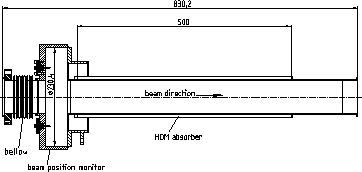
Since the field maximum of the common modes is on the cavity axis, they will
be excited much stronger than the ![]() by a beam near the axis.
The estimated resolution near the electrical center is only 60
by a beam near the axis.
The estimated resolution near the electrical center is only 60 ![]() m,
due to residual signals even at
m,
due to residual signals even at ![]() .
This can be reduced by combining two opposite outputs in a
field selective filter [2].
Because of the limited space inside the cryostat, a stripline hybrid
was used outside. The rejection of common field components is limited by its finite
isolation between the
.
This can be reduced by combining two opposite outputs in a
field selective filter [2].
Because of the limited space inside the cryostat, a stripline hybrid
was used outside. The rejection of common field components is limited by its finite
isolation between the ![]() - and the
- and the ![]() -port; an isolation of
-port; an isolation of
![]() brings the theoretical resolution down to less
brings the theoretical resolution down to less ![]() .
In addition, a frequency sensitive
.
In addition, a frequency sensitive ![]() -rejection of about
-rejection of about
![]() is required to detect a beam displacement of
is required to detect a beam displacement of ![]() .
.
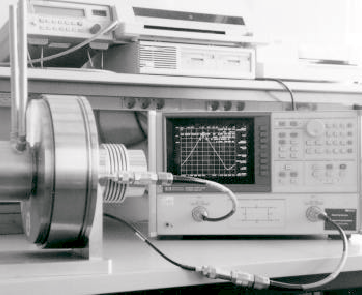
The resolution near the electrical center of the cavity is limited by the thermal noise of the
electronics, too. Assuming a cavity without perturbations and a bunch charge of ![]() ,
a S/N-ratio of 140 can be estimated for a beam offset of
,
a S/N-ratio of 140 can be estimated for a beam offset of ![]() m from the cavity center
[2].
m from the cavity center
[2].
The ![]() -amplitude is detected in a homodyne receiver by mixing the
cavity output and a reference signal down to DC (Fig. 3).
When the beam is on the right, the system can be set up to give positive video polarity.
The signal changes the phase by
-amplitude is detected in a homodyne receiver by mixing the
cavity output and a reference signal down to DC (Fig. 3).
When the beam is on the right, the system can be set up to give positive video polarity.
The signal changes the phase by ![]() when the beam moves to the left,
and for a centered beam it becomes zero.
when the beam moves to the left,
and for a centered beam it becomes zero.
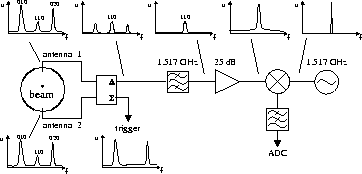
The stopband attenuation of the bandpass filter is more than ![]() .
Together with the hybrid and the coupling factors this gives a
frequency sensitive common mode rejection of about
.
Together with the hybrid and the coupling factors this gives a
frequency sensitive common mode rejection of about ![]() .
Because of the isolation of the hybrid and between both
.
Because of the isolation of the hybrid and between both ![]() -polarizations,
the full aperture was divided into two measurement ranges.
-polarizations,
the full aperture was divided into two measurement ranges.
By using a Quadrature IF Mixer, no additional phase stabilization for the reference is needed. The mixer LO/RF-isolation determines the dynamic range of the electronics. After passing low-pass filters and bipolar video amplifiers, the signal may be either viewed directly on an oscilloscope for adjustment, or digitized by 12-bit ADCs for the quadrupole alignment.
Bench tests were carried out on a stainless steel prototype
to determine the resolution near the center and to test the electronics.
Therefore, the cavity was excited by an antenna, fed by a network analyzer.
A resolution of about ![]() was measured in the frequency domain
[2].
was measured in the frequency domain
[2].
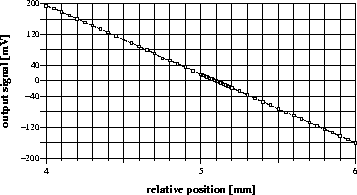
In addition, a prototype was tested at the CLIC Test Facility (CERN) to demonstrate
the principle single bunch response and to measure
the ![]() -amplitude as a function of the relative beam displacement.
The BPM was installed in the spectrometer arm and the beam was moved vertically
by changing the current of the steering coil.
-amplitude as a function of the relative beam displacement.
The BPM was installed in the spectrometer arm and the beam was moved vertically
by changing the current of the steering coil.
A ![]() signal from the timing system was fed to
a step recovery diode and the 6th harmonic was mixed with the
signal from the timing system was fed to
a step recovery diode and the 6th harmonic was mixed with the ![]() -signal.
The output of the electronics vs. the relative beam position is shown in Fig. 5.
Due to the measurement position, the mechanical setup and some machine parameters it
was not possible to measure the minimum detectable signal near the center.
-signal.
The output of the electronics vs. the relative beam position is shown in Fig. 5.
Due to the measurement position, the mechanical setup and some machine parameters it
was not possible to measure the minimum detectable signal near the center.
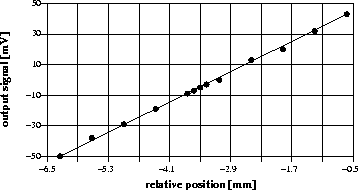
Stripline monitors were selected for the experimental area and a temporary beamline because
of the relaxed requirements - 100 ![]() m resolution around the center - and the warm location.
All monitors consist of four 50
m resolution around the center - and the warm location.
All monitors consist of four 50 ![]() coaxial striplines, positioned 90 degrees apart
in azimuth (Fig. 6). The housing for the one in the dipole arm has a larger beam
pipe diameter (
coaxial striplines, positioned 90 degrees apart
in azimuth (Fig. 6). The housing for the one in the dipole arm has a larger beam
pipe diameter ( ![]() instead of
instead of ![]() ).
).
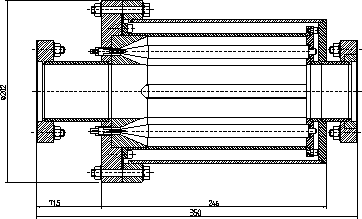
The BPM body is machined from a single block of stainless steel, four holes and the beam aperture are drilled. Each electrode is 175 mm long and shortened at the end; the geometrical coupling factor is approximately 3%. The main distortion in the transition from the electrode into the cable is caused by the feedthrough, selected for mechanical reasons. All 9 monitors were built and tested at DESY-IfH Zeuthen.
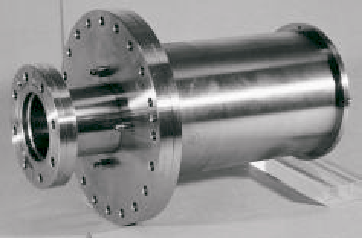
The electronics to detect the ![]() -signal of two
opposite electrodes were built and tested (signals, linearity, drift)
by INFN-LNF [3]. Since the signal has to be measured on a time
scale of a few microseconds, the usage of a single channel for all electrodes
and a multiplexing scheme was impossible. Hence,
the signal processing is done in the frequency domain by
using the amplitude-to-phase conversion scheme together with heterodyning
(intermediate frequency of
-signal of two
opposite electrodes were built and tested (signals, linearity, drift)
by INFN-LNF [3]. Since the signal has to be measured on a time
scale of a few microseconds, the usage of a single channel for all electrodes
and a multiplexing scheme was impossible. Hence,
the signal processing is done in the frequency domain by
using the amplitude-to-phase conversion scheme together with heterodyning
(intermediate frequency of ![]() ).
The generation of a normalized output (position vs. current) over a wide dynamic range
is the main advantage of this system. Furthermore, it is relatively insensitive to
electromagnetic noise.
).
The generation of a normalized output (position vs. current) over a wide dynamic range
is the main advantage of this system. Furthermore, it is relatively insensitive to
electromagnetic noise.
A peak-to-peak noise of less than ![]() was measured,
corresponding to a position resolution of about
was measured,
corresponding to a position resolution of about ![]() .
This agrees very well with bench test results, where the position of a thin
wire was changed until the first `significant' readout of the electronics
was detected (see also Fig. 8, from [4]).
The whole system (monitor and electronics) gives a linear
response for off-center positions up to
.
This agrees very well with bench test results, where the position of a thin
wire was changed until the first `significant' readout of the electronics
was detected (see also Fig. 8, from [4]).
The whole system (monitor and electronics) gives a linear
response for off-center positions up to ![]() .
.
All monitors and the first electronics module are now at DESY Hamburg, awaiting a real beam.
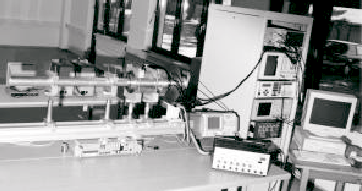
It is a pleasure to thank our colleagues from INFN Frascati, especially P. Patteri, for developing, building and testing the stripline electronics. Finally, we acknowledge the technical support from DESY-IfH Zeuthen and from BESTEC Berlin-Adlershof.